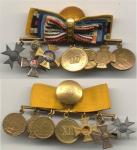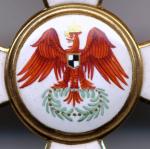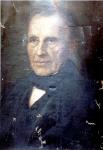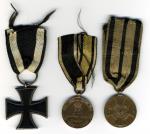-
Posts
907 -
Joined
-
Last visited
-
Days Won
4
Content Type
Profiles
Forums
Blogs
Gallery
Events
Store
Everything posted by medalnet
-
Collecting is an interesting and exciting hobby. It still can be frustrating if information isn't obtainable. When I started out - 15 years ago - collecting German orders, decorations and medals I had little, actually absolutely no knowledge about this complex topic. Needless to say that the first 15 pieces, bought from hard earned pocket money, were all fakes. Looking back to this incident I think I made the right experience. I should have strived for more information. Instead, I just wanted to accumulate as fast as possible all those pretty and interesting medals. I don't think this should happen to anybody else. Especially since there are so many different sources of information in today's world. The number of publications, books and collectors, even societies, is in any case quite different than 15 or 20 years ago. Getting the right information is way easier these days and makes our hobby more enjoyable. Building a collection does make even more fun, when information is shared in-between collectors. I would like to make my experience accessible for all those who are not only accumulating their treasures, but looking for the history behind orders, decorations and medals. Have fun working your way through my ?Web-Space? and always keep in mind, that I am still looking for rare orders , decorations and medals for my own collection. www.medalnet.net Andreas M. Schulze Ising
-
Rick, you are certainly correct. one should never post things here during work ours being distracted by "more important" things then medals ( well, is it?) I believe the regulation in the statues is worded that way, the true meaning is the years served for King/Emperor and counrty!!! I know of a Red Eagle Order 2nd class with oak leaf and jubilee number "65" given to a priest with a long career in a clerical office at the Prussian state. Holding the order for 65 years would be a real miracle.
-
Dear Stogie, I hate to say this, but all jubilee numbers have been faked. Regardless of medal or order or grade. The best ones I have seen are again those elecrosculptured ones. Most were made in Wuppertal, Germany, as well as down south in Germany. The number of fakes is not that high, but they exist. I have had a special interest in those numbers and have accumulated a fair number of awards with those numbers, to find out that they follow the same regularity as the orders they are attached to. Each manufacturer had its own "handwritting" and way of finishing them. Fact is: very rare specialty awards. Imagine holding a red Eagle order for over 50, 60 or even 65 years....
-
I may have to translate this article on my web page into English over the upcoming holidays: http://www.medalnet.net/Red_Eagle_Order_Medal.htm The Red Eagle medal had no clear rules of how to be awarded. When renewed/reissued on March 10, 1871, 400 examples were ordered through the state chancellery. Initial awards were made to the guards of the grand head quarters in Berlin. Those were worn on the Hohenzollern ribbon. Wilhelm I. decreed in 1873 that the Red Eagle medals were only to be awarded to those military persons that never participated in a war. Those awards had to be made to enlisted and NCO ranks and only on the orange white ribbon. It was further OK to award the medal to court servants. Some medals were awarded in 1910 to Prussian citizens, but were disliked by the emperor. Medals were never again awarded for this purpose. Looking even further back to the initial medal with the FW IV on the reverse it seems to me that this medal was given out as a personal distinction of the emperor, mostly to officials/military personnel serving at court events. But this is just my opinion. Documents have not been seen yet, which underlines the rather personal character of this award.
-
Yes, sorry, batch means mini series of a specific number of pieces. I have seen roman numbering on Red Eagle Order stars as high as XXVIII = 28. I am not quite sure about the swadow. What do you mean? The black liner is stenciled, the red filled in in my opinion. This is why the later pieces mostly have faded red and missing pieces of the red.
-
The fact is that they are batch made. some pieces have even sequential numbering in order to piece a series of a batch correct together. One can easily observe this with Red Eagle stars. 90% has roman numbering inside the medalion center. The golden commander crosses of the Saxon Order of Albert show this as well on the joined insde the crown. Another add to what Brian said...the paintings are indeed stencil based.
-
...no nothing to add. well explained. Let me maybe add as a general comment that there is a new series of fakes of the Red Eagle Order coming to the market. This one looks very similar to those I had in hand. The painting resembles those pieces made by either "Humbert & Sohn" or "Hanf & Zimmerman" during the 1850th, just like this one. Certainly one of the best fakes of imperial German orders I have seen so far.
-

EK 1914 Iron Cross 1813 group
medalnet replied to medalnet's topic in Germany: All Eras: The Iron Cross
Yes, I do. this is the reason why I needed a new one. Let me know when I can have it back -
I guess one should pay attention to the other forums...I just posted a few pictures on the orders and decoratins part.... Here the link to it: Iron Cross 1813
-

EK 1914 Iron Cross 1813 group
medalnet replied to medalnet's topic in Germany: All Eras: The Iron Cross
-

EK 1914 Iron Cross 1813 group
medalnet replied to medalnet's topic in Germany: All Eras: The Iron Cross
-
Never having had in mind to lead my collecting interests away from enameled order decorations, I received this little group of medals with yesterday?s mail. The possible recipient was a man named: ?Schmidt?, which is unfortunately all the grand daughter could tell me. She was kind enough to take a picture of her ancestor and email it to me. You will see him wearing besides the Iron Cross the Russian St.George Cross, which unfortunately didn?t survive the last 192 years. Yet the 1813/1814 combatant medal survived and seemed to have been worn on an interesting ribbon. Made in one weave, it represents the Iron Cross ribbon as well as the ribbon of the commemorative medal itself. His 1848/49 commemorative medal survived as well. About the Iron Cross: the Iron core rattles and it looks like it was soldered on the top left frame tip, only. Besides, it is rather thick with about ~2.5 mm.










